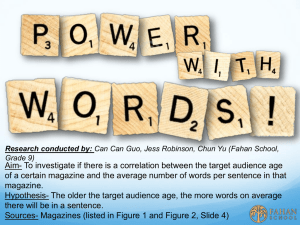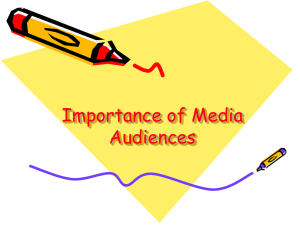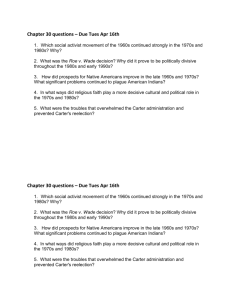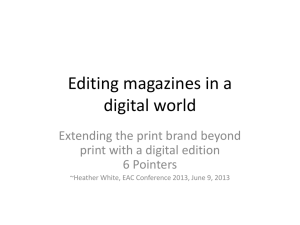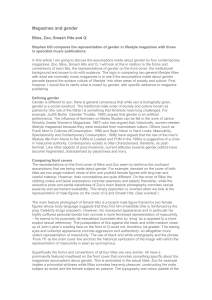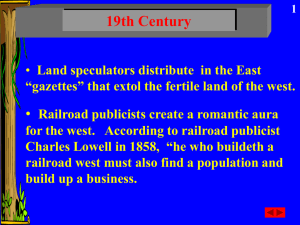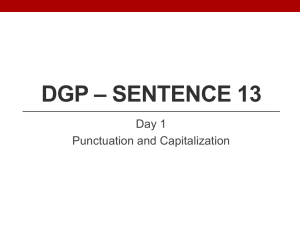History of The Music Press
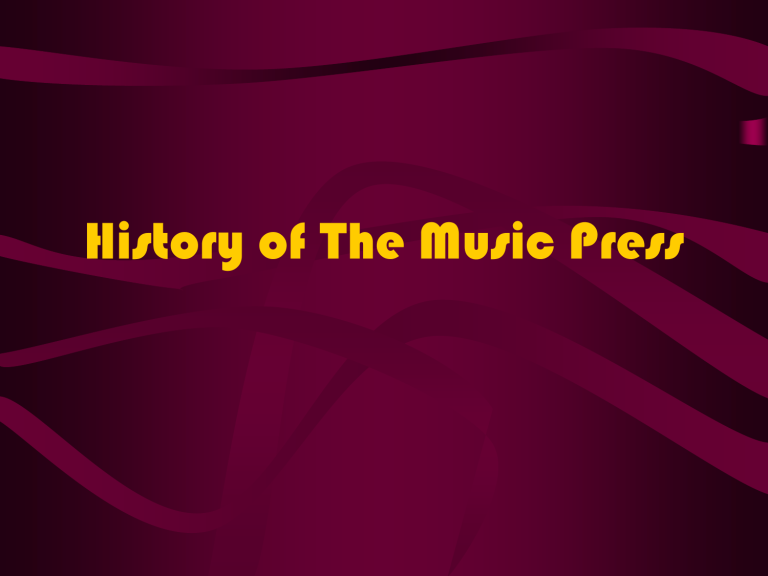
History of The Music Press
Lesson Objective
• At the end of the lesson we will have developed an understanding of the history of music press.
The beginning
Billboard magazine is an important contributor to the development of the music press because it was one of the first publications devoted to the music industry.
It was first printed in 1894 , but it was in
1936 that is published the ‘music hit parade’ that gradually evolved into top 40 charts.
It is primarily aimed at music professionals.
1950s – 1960s
Melody Maker / New Musical Express
•To start, music magazines were largely uncritical of musicians’ output – everything was always good !
•Their content was mainly charts and singles, gig listings.
•These two were often referred to as ‘inkies’
Melody Maker was a weekly newspaper that began in 1926 . Initially, it was renowned for its coverage of jazz music.
After the introduction of it’s rival, New Musical
Express, in 1952 ,which seemed to have a more youth-orientated appeal, it broadened it’s coverage.
Both New Musical
Express and Melody
Maker played a huge part in developing a tabloid newspaper format for music news.
They offered weekly information on all upcoming record releases, with articles on artists and their music.
1960s
During the 1960s and 1970s, these magazines dominated UK newstands, as they were the only up-to-the-minute access to the music scene at the time. This is important because music was a huge part of youth identity.
1960s
Changes in society in the 1960s with the arrival of bands like
The Beatles and The
Rolling Stones, plus the rising drug culture, changed the nature of music and music writing.
1960s continued
The music fanzine is considered to have emerged in the 1960s – these magazines included online),
Crawdaddy (which is still available today
Mojo Navigator and Who Put The Bomp!.
The creation of such amateur publications highlighted a desire to document a music.
‘scene’ of
Fanzines are very much alive on the internet, even today.
Rolling Stone was created by Jann Wenner in the
1967. It was a fortnightly
publication which contained a mixture of current affairs, celebrity interviews and coverage of the music industry. Its appeal lay in the way the journalists addressed the
youth audience.
Rolling Stone was less about factual information and more about music culture.
1970s
The Early 1970s saw the music industry change, first with “Glam Rock” –
Sweet, Mud, Slade, T Rex – and then ‘Prog. Rock’ – David Bowie, ELP and
Yes. Music papers were still largely uncritical of groups until the later years, when it was noticed that Prog. Rock bands were spending more on staging, lasers and lighting than actually making good music.
Mid 1970s
In the mid 1970s writers began to move away from simply writing about music and started writing about “serious” issues such as politics, philosophy, etc.
The “Music Press” became divided between Musicians’
papers such as Melody Maker and Political papers such as bands and their songs).
(techniques, “proper music”)
NME (the meaning behind the
The NME changed its style in this period to meet the changes, especially the introduction of Punk, head on.
New writers were recruited from the magazine’s own readership, with ads like
‘wanted: hip young
gun slingers’. Julie
Burchill became a top
NME reporter overnight.
Late 1970s – Early 80s
However, readers started to abandon NME because it no longer wrote about
“normal” bands and was too obsessed with itself and its politics.
In fact, 1978 saw the start of a new type of music magazine…
1978
Smash Hits launched a new glossy mag catering for a younger audience in a smaller magazine format. Its focus was on “trivia” – favourite colours, food, pop-musicians’ lifestyles, etc.
It included polls, letters, surveys, fan club information, all in an attempt to keep in touch with their readership
– People wanted lyrics, posters, free gifts on the covers...so they got them!
The emphasis of these magazines was
pop, which paved the way for contemporary celebrity magazine obsessions.
Late 1970s – Early 80s
Style in pop music became more important than content: make-up, clothes, the video, fashion and hair.
1980s
Independent music labels wanted their own voice and began producing more
fanzines. These fanzines were often typed, photocopied and
distributed at concerts or by subscription.
Despite the handmade appearance this encouraged a whole new generation of writers, photographers and cartoonists to contribute.
1980s
The 80s saw a new layout of magazines – “style” magazines such as The Face and Blitz became popular, not just for music but information about the latest fashions and hairstyles.
There was a lot of experimentation with typefaces, layout, graphic design, making the music press new and
more exciting with breaking the rules.
Many critics argued that these new glossy magazines – tabloid and style based - left a void in which the serious consideration of new and usually
‘ indie ’ music floundered.
1980s
Kerrang! arrived in
1981. It evolved from the template created by Smash Hits , though it tried to have a more
‘flippant’ mode of address. It’s target audience was very genre-specific teens.
1980s
Q was first published in
1986 by EMAP, a company that owns many other music magazines.
It attempted to draw on sophisticated journalism, and reflected an older demographic of readers.
It fast became one of the biggest selling music titles in the UK.
1980s
The Wire is an avant-garde title launched by jazz enthusiasts Anthony
Wood and Chrissie Murray in
1982.
Though the magazine originally focused on jazz music it branched out over the years to include other musical forms with an emphasis on the avant-garde . In the late 1990s it began to use the term ‘ post-rock ’ to describe its more eclectic musical interests that included hiphop, reggae, rock, dance music, electronica, jazz, new age and contemporary classical
The Wire is everything that Smash Hits is not: sophisticated instead of tacky, critical instead of fawning and masculine perhaps, instead of feminine.
1990s
New technologies began to emerge in the 90s. Music videos became popular which began to change many aspects of the ways in which music is consumed.
Every single comes with a video; sometimes more money is spent on the video than the single.
The launch of MTV, the first TV market for music videos, allowed even little known bands to make lots of money and impact with a well made video.
Several other British magazines such as
Select and Sounds also folded between
1990 and 2000
1990s
The proliferation of music journalism in newspapers, on television, radio and the internet saw a slump in sales figures for mainstream titles .
Although the 21st century has seen many magazines marginalised by the Internet and other digital media, this has resulted in the streamlining and increased specialisation of magazine publishing.
1990s
Different genres of music started to get their own magazines during this decade.
Magazines like Mixmag, which had a club/dance music focus, and The Source,
Classic Rock and Hip-Hop were all produced starting in the 1990s.
Declining sales of Melody Maker resulted in a glossy magazine format in 1999 and an eventual merger with its long-time rival, NME, in 2000.
Today, the NME has diluted its newspaper identity in favour of a magazine costume change.
2000s
Today – is there a limited “music press” because “everything is pop culture”?
Daily newspapers feature pop stars and “celebrities” appear on daytime
TV.
People are famous for being famous.
Anyone in a band or with some talent assumes that they have a right to be rich and famous.
2000s
There has been a considerable shift since the 1980s, when magazines like Smash
Hits regularly sold in excess of half a million copies an issue. In fact, the magazine closed in
2006, with sales having shrunk to less than
100,000.
2000s
Music magazines in the Noughties were increasingly niche marketed at very specific sub cultural demographics, with very specific strategies for listening.
And, on the one hand, this is a product of the over-riding strategic editorial policies of large media groups like BAUER for whom titles like Q and Kerrang!
are but one product within their consumer portfolio.
On the other hand, it is also a product of the inevitable retrospectivism brought about by the digital revolution .
Plenary
• How do bands use the internet to promote themselves in the digital age?
• How do you think the record industry has changed over the last ten years?
• How has the music press accommodated the changes to the way in which people listen to music?
